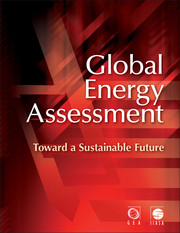Book contents
- Frontmatter
- Contents
- Section 1
- Section 2
- Section 3
- Cluster 1
- Cluster 2
- Chapter 7 Energy Resources and Potentials
- Chapter 8 Energy End-Use: Industry
- Chapter 9 Energy End-Use: Transport
- Chapter 10 Energy End-Use: Buildings
- Chapter 11 Renewable Energy
- Chapter 12 Fossil Energy
- Chapter 13 Carbon Capture and Storage
- Chapter 14 Nuclear Energy
- Chapter 15 Energy Supply Systems
- Chapter 16 Transitions in Energy Systems
- Cluster 3
- Cluster 4
- Section 4
- Index
- References
Chapter 9 - Energy End-Use: Transport
Published online by Cambridge University Press: 05 September 2012
- Frontmatter
- Contents
- Section 1
- Section 2
- Section 3
- Cluster 1
- Cluster 2
- Chapter 7 Energy Resources and Potentials
- Chapter 8 Energy End-Use: Industry
- Chapter 9 Energy End-Use: Transport
- Chapter 10 Energy End-Use: Buildings
- Chapter 11 Renewable Energy
- Chapter 12 Fossil Energy
- Chapter 13 Carbon Capture and Storage
- Chapter 14 Nuclear Energy
- Chapter 15 Energy Supply Systems
- Chapter 16 Transitions in Energy Systems
- Cluster 3
- Cluster 4
- Section 4
- Index
- References
Summary
Executive Summary
The world's demand of fuels for transportation has multiplied over the last decades due to the concurrent fast expansion of population, urbanization, and global mobility. The global transport sector is responsible for 28% of total final energy demand. The majority of the energy used in transportation – 70% – is utilized on the movement of passengers and goods on roads locally, nationally, and across regions. Transportation weighs heavily on climate, energy security, and environmental considerations, as 95% of transport energy comes from oil-based fuels. Transportation is the cause of other critical challenges due to its supporting role in local and global economies, as well as the implications of increasing transportation on human health and social interactions. The immense and multi-faceted challenges of a global transportation system deeply rooted in fossil fuels are compounded by the quickly evolving aspirations of a worldwide population that is increasingly on the move and has learned to regard mobility, in particular by motorized modes, as an important component of the modern lifestyle they have or are seeking to attain.
This chapter evaluates the roots of these challenges and outlines the options for a feasible major transformation of the global transportation system over the next 30–40 years. The goal of this transformation is the development of a robust path for the consolidation of transportation systems around the world that can deliver the mobility services needed to support growing economic and social activity while also creating the conditions for enhanced energy security, rigorous climate change mitigation, improved human health, better environment, and urban and social sustainability.
- Type
- Chapter
- Information
- Global Energy AssessmentToward a Sustainable Future, pp. 575 - 648Publisher: Cambridge University PressPrint publication year: 2012
References
- 26
- Cited by



